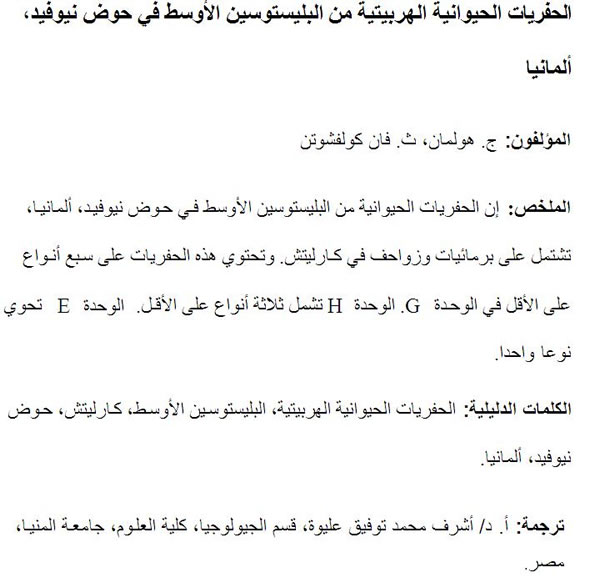|
The Middle Pleistocene Herpetofaunas from Kärlich (Neuwied Basin, Germany) Reptiles and amphibians, often grouped together as the Herpetofauna, form a major part of the terrestrial as well as the aquatic vertebrate animals representing a large number of species. Herps are poikilithermic (‘cold-blooded’), ectothermic tetrapods and amphibians in particular are often very sensitive for environmental changes and in many cases restricted to specific climatic conditions and a specific habitat. Fossils herpetofaunas are therefore often used to suggest palaeoenvironmental conditions e.g. during the Quaternary. Most Quaternary amphibians and reptiles represent extant species whose ecological tolerances and habitat preferences are well known. In order to collect information about the environmental conditions during deposition of the sediment layers exposed in the Kärlich quarry (Germany), including the levels Kärlich G and Kärlich H which yielded Palaeolithic artefacts, the fossil vertebrate faunas have been studied. Amphibians and reptiles have been found in the Middle Pleistocene levels Kärlich units E, G, and H ranging in age from about 700 – 300 thousand years ago. In Kärlich E only a fossil toad has been found; Kärlich H yielded at least one salamander and two lizards. The most diverse herpetofauna was recovered from level G, and contains at least seven species, including two salamanders, one anuran, and four lizards. The herpetofauna indicates that a still-water habitat such as a marsh or pond had to be somewhere near the site in order for these animals to breed. The presence of the Slow Worm suggests that low vegetation and ground cover must have been present; and the lizards, especially the Sand Lizard, indicates that a relatively dry at least somewhat sandy habitat must have been available. Resumen en EspañolLas herpetofaunas del Pleistoceno medio de Kärlich (cuenca de Neuwied, Alemania) La localidad de Kärlich es bien conocida porque en ella aflora una dilatada secuencia de depósitos cuaternarios que han proporcionado restos de pequeños y grandes mamíferos, así como artefactos paleolíticos del Pleistoceno medio. Además de los restos de mamíferos, el registro de vertebrados de Kärlich incluye anfibios y reptiles en las unidades E, G y H. La herpetofauna más diversa ha sido recolectada en el nivel G y contiene, al menos, siete especies (dos salamandras, un anuro y cuatro lacertilios). El nivel H ha proporcionado, al menos, una salamandra y dos lacertilios, y el nivel E una especie de anuro. PALABRAS CLAVE: Herpetofauna; Pleistoceno medio; Kärlich; cuenca de Neuwied; Alemania Traducción: Miguel Company Résumé en FrançaisLes herpétofaunes du Pléistocène moyen de Kärlich (Bassin de Neuwied, Allemagne) La localité de Kärlich est bien connue pour l'exposition d'une longue séquence de dépôts quaternaires ayant livré des restes de petits et grands mammifères ainsi que des artefacts paléolithiques du Pléistocène moyen. A part les restes de mammifères, les vertébrés à Kärlich sont aussi représentés par les amphibiens et les reptiles dans les unités E, G, et H. L'herpétofaune la plus diversifiée provient du niveau G et contient au moins sept espèces dont deux salamandres, un anoure, et quatre lézards; Le niveau Kärlich H a livré au moins une salamandre et deux lézards; Kärlich E quant à lui n'a livré q'une espèce d'anoure. Mots-Clefs: Herpétofaune, Pléistocène moyen, Kärlich, Bassin de Neuwied, Allemagne Translator: Loïc Costeur Deutsche ZusammenfassungDie Herpetofauna des Mittleren Pleistozäns von Kärlich (Neuwieder Becken, Deutschland) Die Kärlich-Lokalität ist wohlbekannt aufgrund einer langen Sequenz von quartären Ablagerungen mit großen und kleinen Säugetierresten und den frühen mittel-pleistozänen paläolithischen Artefakten. Zusätzlich zu den Säugetierfundstücken gibt es in Kärlich weitere Wirbeltierfossilien der Gruppen Amphibien und Reptilien in den Kärlich-Einheiten E, G und H. Die am stärksten diversifizierte Herpetofauna fand sich in Einheit G, hier konnten mindestens sieben Arten, darunter zwei Salamander, ein Froschlurch und vier Eidechsen identifiziert werden; Kärlich-Heinheit H enthielt mindestens einen Salamander und zwei Eidechsen-Arten; und in Kärlich-Einheit E wurde eine Froschlurch-Spezies gefunden. SCHLÜSSELWÖRTER: Herpetofauna; Mittleres Pleistozän; Kärlich; Neuwieder Becken; Deutschland Translator: Anke Konietzka
Translator: Ashraf M.T. Elewa Polski AbstraktHerpetofauna środkowego plejstocenu Kärlich (basen Neuwied, Niemcy) Stanowisko Kärlich jest dobrze znane ze względu na odkrycie długiej sekwencji osadów czwartorzędowych zawierających szczątki dużych i małych ssaków, jak i artefaktów paleolitycznych z okresu wczesnego środkowego plejstocenu. Oprócz ssaków kręgowcowy zapis kopalny z Kärlich zawiera również płazy i gady w jednostkach E, G i H. Najbardziej zróżnicowaną herpetofaunę odkryto w poziomie G i zawiera ona co najmniej siedem gatunków, w tym dwie salamandry, jeden gatunek płaza bezogonowego, oraz cztery jaszczurki. Kärlich H wydał zaś co najmniej jedną salamandrę i dwie jaszczurki, zaś poziom H Kärlich zawierał jeden gatunek płaza bezogonowego. Słowa kluczowe: herpetofauna; środkowy plejstocen; Kärlich; basen Neuwied; Niemcy Translators: Dawid Mazurek, Robert Bronowicz, and Daniel Madzia Riassunto in ItalianoLe erpetofaune del Pleistocene medio di Kärlich (Neuwied Basin, Germania) La località di Kärlich è ben conosciuta in quanto espone una lunga sequenza di depositi quaternari contenenti resti di macro- e micro mammiferi del Pleistocene medio basale, nonchè manufatti litici del Paleolitico. Oltre ai resti mammaliani, il record a vertebrati di Kärlich include anfibi e rettili nelle unità E, G, e H. L’erpetofauna più diversificata è stata recuperate dal livello G, e consiste di almeno sette specie: due salamandre, un anuro e quattro lucertole; il livello Kärlich H contiene almeno una salamandra e due lucertole, mentre a Kärlich E è stato rinvenuto solo un anuro. PAROLE CHIAVE: erpetofauna; Pleistocene medio; Kärlich; Neuwied Basin; Germania Translator: Chiara Angelone |
|
